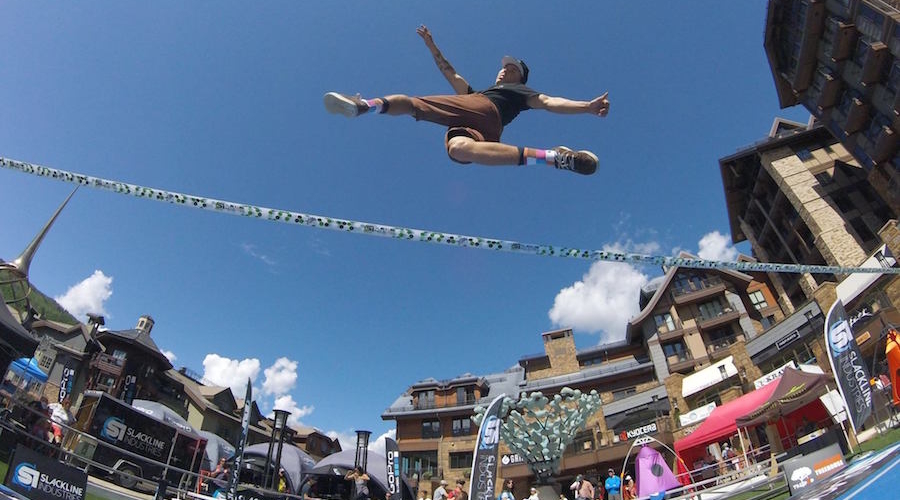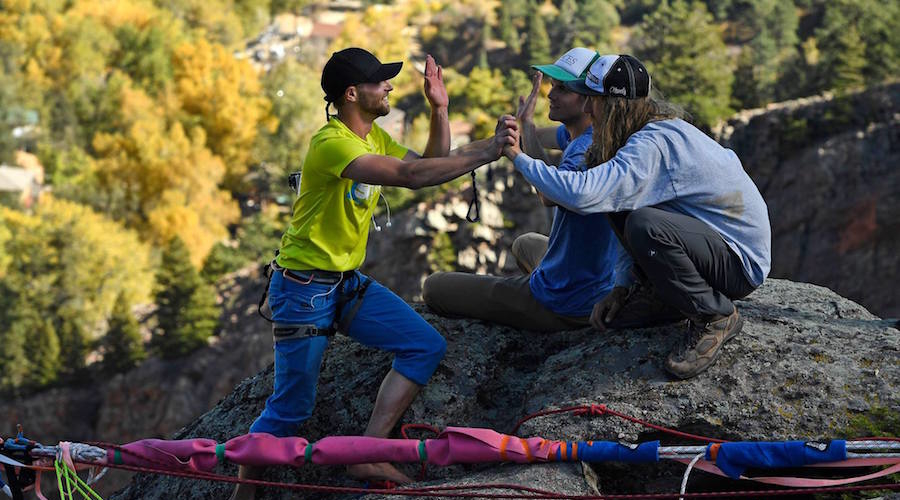SGB spoke with Frankie Najera of Slackline Industries about the history of slacklining and why anyone can do it.
By Carly Terwilliger
You’ve probably seen a slackliner, even if you didn’t have a name to go with the sport.
The idea is, you take a narrow, flexible piece of webbing and string it between two anchors – usually trees. Then you get up and walk on it.
“It’s a lot like tightrope walking. The major difference is that that slacklines are looser and have more bounce,” explained Frankie Najera, multimedia manager at Slackline Industries, a designer and manufacturer of slackline equipment based in Boulder, CO. “Slacklining actually came directly out of climbing. The story goes that climbers at Camp 4 in Yosemite started walking on webbing lines they’d hung up, and it grew from there.”
Slackline Industries, a subsidiary of Canaima Outdoors, sponsors a group of competitive international slackliners, but they don’t just cater to the intrepid souls bouncing on a one-inch line above a canyon. “We have a big focus on beginners who get a wide one and set it up low to the ground,” said Najera. “For just starting out, about one-two feet off the ground is good. For tricks and bounces, you have to move it higher.”
The sport was born and grew up as rock climbing’s less visible cousin, tucked into indoor climbing gyms and practiced by the diehards found inside. In the age of instantly available video, its scope is quickly widening. “It has changed over time,” Najera observed. “Years ago, people pretty much would get into it through climbing. Now someone might see a slackliner doing crazy stuff in an online video, and get into it that way.”
Or in Najera’s case, “My wife actually got me into it. We’re both climbers. I’m from San Diego and I was working setting routes in a climbing gym, and I’d be slacklining like six hours a day.” Apparently it grows on you, especially if you have someone with whom to practice and improve.
Najera also sees the opportunity for crossover between other active pursuits. “In Colorado, there’s a lot of students and active lifestyle people – if you do yoga, if you climb, you might get into slacklining.” The time investment is relatively small – according to Najera with focus and the right equipment you can pick it up in a day. Slackline Industries’ least expensive kit is $65, so the initial cash layout is minimal as well.
And it’s not the kind of thing that you have to be a super-athlete to enjoy. Commented Najera, “It puts everyone on a level playing field. No matter what your body type, you can do it. My four-year-old daughter can walk a line with only a little help. I’ve seen people in their 80s do it.”
So who – besides precocious toddlers and badass grandparents – will you be hanging with if you get into slacklining?
“The slackline community is very accepting, very open,” said Najera. “They’re not prejudiced. Wherever, you go, you don’t need to speak the language to connect with them. I don’t speak Portuguese, I don’t speak Japanese, but I can have a great time with slackliners in Brazil or Japan.”
The reason: “We all speak slackline.”
Because slacklining, while growing in popularity, is still a bit of a niche sport, we wrapped up by asking Najera about the strangest sport he’s seen in his travels. “There’s this thing I saw in Germany where it’s basically table tennis, but you play it with a soccer ball and the players hit it with their heads.” We looked it up – it’s called Headis and it is indeed bizarre.
Compared to that, slacklining seems like a carefully balanced walk in the park.
Photos courtesy Slackline Industries












